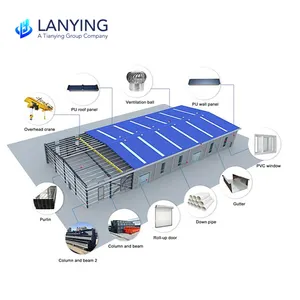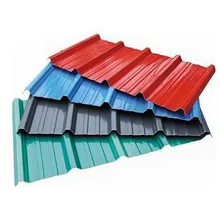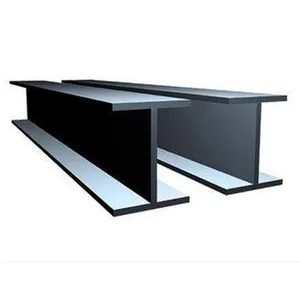What are Steel Structures
Steel structures are engineered assemblies made from steel components that are designed to support loads and provide structural integrity. They are a staple in modern construction, used for a variety of applications including buildings, bridges, towers, and warehouses. The construction industry, in particular, has adopted steel structures due to their strength, durability, and flexibility. These structures are not only meant for large-scale commercial and industrial projects but can also be tailored for small businesses and local contractors.
The principles governing the working of steel structures involve understanding the properties of steel – such as its high strength-to-weight ratio and malleability – which allow it to be formed into various shapes without compromising its structural integrity. Steel structures work by transferring loads through a series of beams, columns, and connections that distribute weight evenly and ensure stability. The design of a steel structure is critical and must adhere to rigorous standards to ensure safety and performance.
Businesses that require facilities with large open spaces, like warehouses or manufacturing plants, often turn to steel structures because they can span great distances without the need for numerous support columns. This results in more usable interior space and versatility within the structure. Additionally, the longevity and low maintenance requirements of steel make it an economical choice over time for any entity investing in infrastructure.
Types of Steel Structures
The array of steel structures available caters to a broad spectrum of needs across different sectors. Each type is characterized by its design features and common applications:
Steel Frame Structures: These are among the most common types of steel structures, characterized by a skeleton frame of vertical steel columns and horizontal I-beams. This framework forms the "ribs" of the structure, facilitating the construction of both small and large buildings. They are widely used for commercial buildings like offices, schools, and shopping centers.
Pre-engineered Buildings (PEBs): PEBs are factory-built buildings shipped to site and bolted together. They offer a quick, standardized, and cost-effective solution for industrial buildings like factories and warehouses.
Steel Truss Structures: Featuring interconnected triangular units for stability, trusses are used in bridges, roof supports, and other structures where large spans are desirable without many support columns.
Light Gauge Steel Construction: This method uses thin sheets of steel that have been formed into shapes resembling wood studs. It is commonly used for residential or small commercial buildings due to its lightweight nature.
Structural Steel Fabrications: These involve custom-made components that cater to specific design requirements. They can include intricate designs for architectural features or specialized industrial applications.
How to choose Steel Structures
Selecting the right steel structure requires careful consideration of several factors to ensure it meets the specific needs of your business. Whether you're constructing a new warehouse or expanding a manufacturing plant, consider the following when making your decision:
Design Requirements: Assess the architectural design to determine if you require standard steel frames or more complex fabrications. For instance, if you need large open spaces without columns, truss structures might be appropriate.
Load-bearing Capacity: The intended use of the building will dictate the load-bearing capacity needed. Industrial facilities with heavy machinery will have different requirements compared to an office building.
Material Grade: Steel is available in various grades with different strength levels. Be sure to match the grade (e.g., Q235 or S355) with your project's structural demands.
Processing Services: Depending on your design needs, you may require additional services such as welding, cutting, or bending which will influence your choice of supplier.
Project Solution Capability: Some suppliers offer comprehensive solutions including graphic design or 3D model design which could be beneficial if you don't have these capabilities in-house.
It's vital to engage with suppliers who understand these nuances and can offer tailor-made solutions that align with your project's specific parameters.
Best Steel Structures on Alibaba.com
When sourcing steel structures for your business projects, Alibaba.com stands out as a premier marketplace connecting you with numerous suppliers worldwide. This platform provides an extensive selection of steel structures suitable for various applications – from industrial warehouses to custom-designed architectural elements.
Alibaba.com simplifies global trade by offering tools that facilitate communication between businesses and suppliers in multiple languages and mobile-friendly interfaces for convenient browsing on-the-go. With services such as Trade Assurance providing payment protection until delivery is confirmed, businesses can procure with confidence knowing their interests are safeguarded.
The diversity in product offerings ensures that whether your project is large-scale or modest, Alibaba.com offers options that align with your structural needs while accommodating customization requests to meet unique specifications. The platform's emphasis on quality assurance further reinforces reliability – ensuring that each transaction moves towards successful project completion without compromising on standards.
Common FAQs for Steel Structures
What are the benefits of using steel structures for construction?
Steel structures provide high strength-to-weight ratios, durability, and flexibility in design. They are ideal for projects requiring large open spaces and can reduce construction times due to their prefabricated nature.
How does the choice of steel grade affect my steel structure project?
The steel grade determines the strength and flexibility of the structure. Higher grades typically offer greater strength and are more suitable for buildings that need to support heavy loads or withstand severe environmental conditions.
Can steel structures be customized to fit specific design needs?
Yes, steel structures can be tailored through various processing services like welding, cutting, bending, and punching to meet unique design specifications and architectural requirements.
Are there eco-friendly options available for steel structures?
Steel is a recyclable material, making it an eco-friendly choice. Additionally, suppliers may offer structures made from recycled steel or designs that minimize waste and energy consumption during construction.
What types of buildings commonly use steel structures?
Steel structures are commonly used for industrial buildings such as warehouses, factories, and distribution centers, as well as commercial buildings like office complexes, retail stores, and sports arenas.
How do I ensure that the steel structure I choose is compliant with building codes?
Engage with suppliers who provide structures that adhere to recognized standards like GB, AISI, ASTM, JIS, BS, DIN, and EN. These compliance markings indicate that the structure meets safety and performance criteria set by industry authorities.
What types of finishes are available for steel structures to prevent corrosion?
Steel structures can be treated with a variety of finishes such as hot-dipped galvanization, painting, powder coating, or applying protective sealants to prevent corrosion and extend the lifespan of the structure.
How do load-bearing considerations impact the design of a steel structure?
Load-bearing considerations dictate the structural elements needed to support the intended use of the building. These elements influence the choice of steel beams, columns, trusses, and connections to ensure stability and safety.
What should I consider when choosing between hot-rolled and cold-rolled steel for my project?
Hot-rolled steel is generally less expensive and ideal for components where finish and precise shapes are not crucial. Cold-rolled steel provides tighter tolerances and a better surface finish. The choice depends on the aesthetic and dimensional requirements of your project.
Are there standard sizes for steel structures or can they be made to measure?
Steel structures can be made in standard sizes; however, many suppliers offer customization options to create structures according to specific project measurements.
What is the lifespan of a typical steel structure?
The lifespan of a steel structure depends on environmental factors, usage, material grade, and maintenance. However, with proper design and protection against corrosion, they can last several decades.
How does climate impact the selection of a steel structure?
Climate considerations such as wind loads, snow loads, seismic activity, and exposure to corrosive environments should influence the selection of materials and design specifications to ensure the longevity and safety of the structure.
Can I expect any after-sale services from suppliers when purchasing steel structures?
Suppliers may offer various after-sale services including onsite inspection, spare parts provision, installation assistance, training on maintenance procedures, or return-and-replacement policies.


































 浙公网安备 33010002000092号
浙公网安备 33010002000092号 浙B2-20120091-4
浙B2-20120091-4